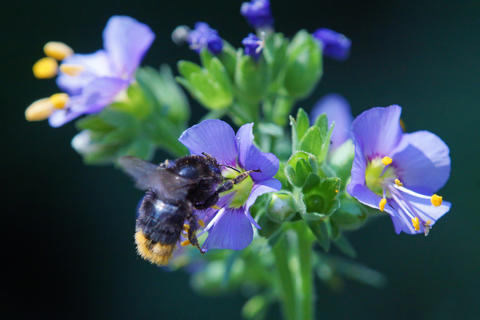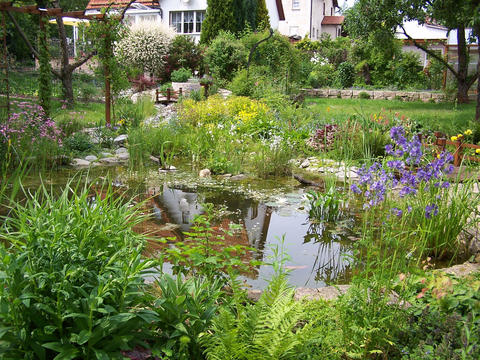Jacob’s Ladder
Jacob’s Ladder (Polemonium caeruleum) enchants with its light blue flowers in June and July. With these tips, you’ll soon have Jacob’s Ladder growing in your garden.
Factsheet
- Growth type
-
- Perennial plant
- Growth height (from)
- from 60 cm to 80 cm
- Growth width (from)
- from 40 cm to 50 cm
- Growth characteristics
-
- upright
- horst-forming
- Flower color
-
- blue
- Flowering time (month)
-
- June to July
- Flower shape
-
- Panicules
- simply
- Shell Flowers
- Leaf color
-
- green
- page format
-
- feathered
- oblong
- Fruit shape
-
- Capsule
- Light
-
- scattered light to semi-shade
- Soil type
-
- sandy to loamy
- Soil Moisture
-
- fresh to humid
- ph value
-
- weakly alkaline to weakly acidic
- Nutrient requirements
-
- nutrient-rich
- Humus
-
- rich in humus
- Decorative or utility value
-
- Flower Decoration
- Nectar or pollen plant
- native wild plant
- Toxicity
-
- non-toxic
- Winter Hardness
-
- hardy
- Climate zones according to USDA
-
- 2
- areas of life
-
- GR2
- GR3
- FR2
- FR3
- B2
- B3
- Use
-
- Flowerbeds
- Bouquets
- flower meadows
- Pond planting
- Garden style
-
- cottage garden
- Flower garden
- natural garden
- Water garden
- Bee Friendly
- bee friendly plant
Jacob’s ladder (Polemonium caeruleum) is a perennial also known as Greek valerian. Flowering in early summer, the Polemonium genus includes around 30 species and is part of the phlox family (Polemoniaceae). Polemonium caeruleum is the only Jacob’s ladder that appears in central Europe. It predominantly thrives in damp meadows, wetlands, river banks and mountainous regions. It is now considered endangered in countries such as Germany. This perennial’s name is based on its long, pinnate leaves that look like they form a ladder from afar. This references a passage from the Bible, where Jacob dreams of a ladder to heaven.
Jacob’s Ladder grows upright, generally reaching between 24 and 31 inches tall. It grows to 16 to 20 inches wide.
The small, alternately arranged pinna of the Jacob’s Ladder are its main identifier, and give the plant its name. The green leaves are generally made up of 19 to 27 leaflets - these may even be bipinnate. This means that the regularly divided foliage of the Polemonium caeruleum forms an excellent backdrop for its blue flowers.
Jacob’s Ladder’s small, sky blue bowl-like flowers appear from June into July. They grow to 0.39 - 0.98 inches wide, appearing in dense, decorative panicles on strong stems. These give way to long, striking yellow or orange stamens. The flowers of nectar-rich and pollen-rich Polemonium caeruleum are favorites of many insects, including bees, bumblebees and butterflies. If you’re looking for a Jacob’s Ladder with a lovely scent, your best bet is purple-flowered Polemonium caeruleum var. villosum.

After the flowers, Jacob’s Ladder forms capsule fruits that contain long seeds.
In the garden, Jacob’s Ladder feels most at home in partial shade. However, it will thrive in sunny positions if watered generously. But in regions with very hot summers, shade is essential.
Jacob’s Ladder’s typical habitats are nutrient-rich meadows in mountainous regions. Even in the garden, Polemonium caeruleum prefers nutrient-rich, permeable, humus-rich soil that is fresh to moist. Waterlogging must be avoided at all costs.
When planting Polemonium caeruleum, you should ensure a distance of at least 16 inches from neighboring plants. Around four to six plants can inhabit one square yard.
Jacob’s Ladder is robust and easy-going when it comes to care. If there are any extended dry periods in summer, however, this herbaceous perennial must be intensively watered. If you cut back Jacob’s Ladder completely after flowering, you will encourage a second bout of flowers in September. These, however, will be less impressive than the first. Polemonium caeruleum has a reputation for voracious self-seeding in the garden. If you want to prevent this, simply chop off the inflorescences after the flowers wilt.
It is advisable to dig up and divide Jacob’s Ladder every two to three years - this encourages the vitality of this early summer bloomer.

Jacob’s ladder is very well suited to perennial beds and looks very nice next to Siberian iris and lady’s mantle (Alchemilla). It also makes a lovely statement in nature gardens, such as in meadow-like areas alongside columbine, meadowsweet, primrose or day lily. It’s a good idea to plant low-growing neighbors at the feet of Jacob’s Ladder plants, such as field chamomile, so that this blue beauty doesn’t look too cool on the ground. With its nostalgic charm, Polemonium caeruleum is especially well suited to cottage gardens but can also be positioned around ponds. Low scented Jacob’s Ladder (Polemonium caeruleum var. villosum) is especially suited for use at the front of the bed. If you like, you can also use Jacob’s ladder as a .
A charming variety of Polemonium caeruleum is “Album”, which grows up to 12 to 20 inches tall and is crowned with white bowl-like flowers. Variegated Jacob’s ladders are really special. The Polemonium caeruleum “Brise d’Anjou” variety is particularly common. Each leaflet of this Jacob’s Ladder is sure to enchant with its creamy-yellow, almost white edging. You can even encourage the growth of this decorative foliage by removing the rather unspectacular flowers. Jacob’s Ladder “Lambrook Mauve” is an interesting pink variety cultivated in England. It stands out with its many delicate mauve flowers and also remains in its habitat, so is very much recommended as an addition to a spring bed. This variety grows up to 20 inches tall and tolerates sun as well as partial shade as long as the soil is sufficiently moist.
Jacob’s ladder can be propagated through cuttings or seed. Growing from seed works best when the seeds are harvested shortly before full maturity and then sown into a tray with a mixture of sand and humus. The trays can then be stored in a protected location in the garden and kept consistently moist. The seeds generally germinate in the following spring, as they need a shock of cold to trigger germination. The easier alternative is to simply let the plant sow its seeds into the bed, then dig up the seedlings the following year to transplant them where you want them.
When it comes to diseases, powdery mildew can infect Jacob’s ladder. Slugs and snails also love these perennials.

